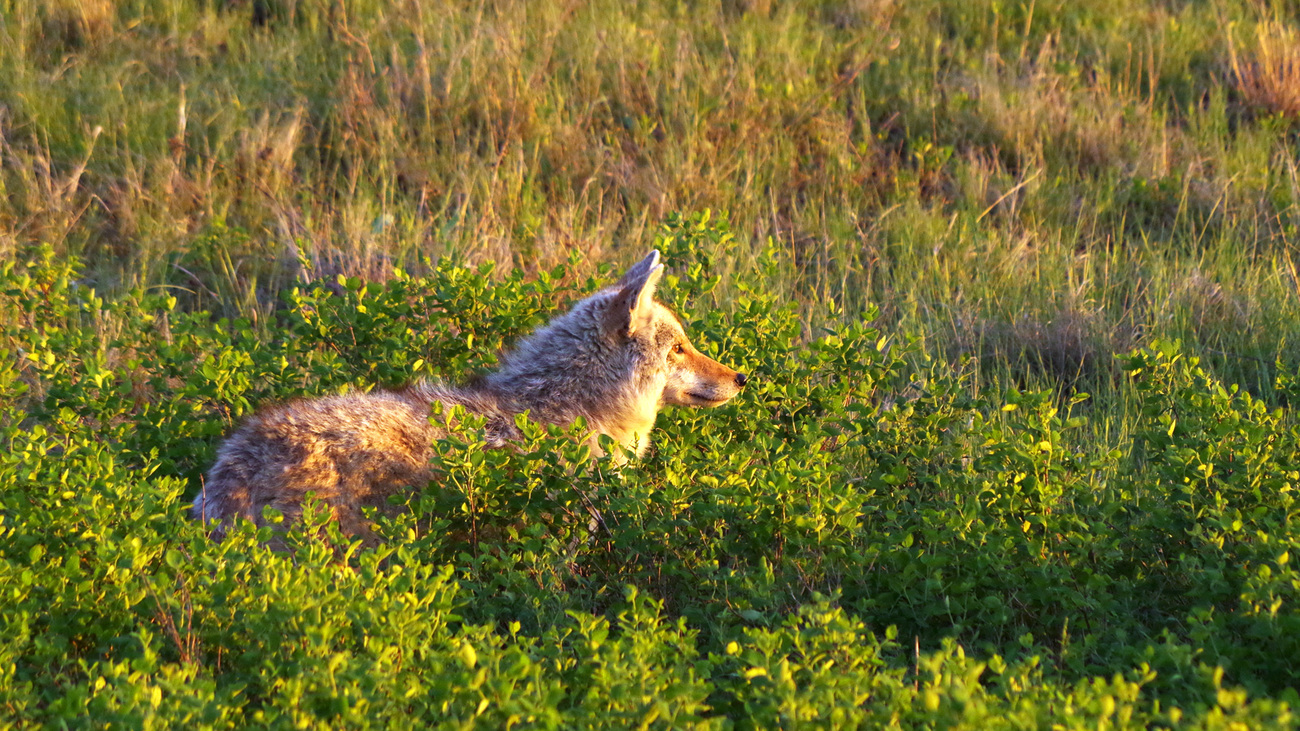Coyotes
Coyotes are members of the dog family, also known as Canidae. Thanks to their highly adaptable nature, they can be found in various ecosystems spread across North America. Their habitats range from forests and grasslands to deserts and even urban areas.
The coyote is characterised by its long, coarse, greyish-brown fur with a lighter underside, as well as a bushy tail, erect and pointed ears, and a long, slender snout. Compared to wolves, coyotes are medium-sized canids with a smaller size and lighter build. A coyote is typically around 60 centimetres (2 feet) tall and up to 1.3 metres (3.3-4.2 feet) long, including a 30- to 40-centimetre (11- to 15-inch) tail. Coyotes’ size and colour can vary depending on the region in which they live. They can weigh anywhere from nine to 23 kilograms (20 to 50 pounds), with the largest coyotes residing in the northeast US and eastern Canada.
Coyotes are proficient hunters. When they run, their tails point downwards, and they can reach speeds of up to 64 kilometres per hour (40 miles per hour). In open spaces, they rely on sight, but where prey may be hiding in a forest or thick vegetation, they will use their keen senses of smell and hearing. Coyotes have opportunistic hunting habits, and they typically hunt as individuals rather than in groups. Their diverse diet consists primarily of mammals, such as deer and rabbits, but may also include frogs, fish, and other prey, as well as fruits, grass, insects, and carrion.
Though known for their distinctive howling and yapping during the nighttime, coyotes may be active both during the day and at night; indeed, they are often most active at dusk and dawn. They are social, intelligent animals who live in groups called packs. A pack of coyotes is generally a family, consisting of a breeding pair, their offspring from the current year, and sometimes older offspring from previous litters. Coyotes cooperate in their packs to provide food, raise pups, and protect their territories together. They use howling, as well as scent marking, to identify their territory. Territory size and range can vary depending on the type of habitat, conditions, and availability of prey, but territories are frequently 10 to 20 square kilometres (6.21 to 12.42 square miles).
The coyote follows a monogamous mating system. Breeding pairs of coyotes form strong bonds that last throughout the mating season. They typically mate between January and March, with a gestation period of up to 65 days. Female coyotes give birth to around four to seven pups in a protective den dug into the ground, where they remain for two to three weeks until they’re strong enough to emerge and play together. At five to seven weeks old, the coyote pups are weaned. Both parent coyotes will contribute to feeding and protecting these pups until they become independent adults at six to nine months old. In autumn, some of the litter will move on, while others stay in the family pack.
Coyotes play a critical role in maintaining healthy ecosystems throughout their range, including through competition, predation, and limiting prey populations. Their hunting and scavenging habits help to clear carrion from landscapes, sustain bird populations through their competition with other predator populations, and otherwise support a balanced food web.
What is a coyote’s scientific name?
The scientific name for a coyote is Canis latrans, which translates from Latin as ‘barking dog.’
Their common name, coyote, is derived from the Nahuatl (Aztec) word coyotl.
The coyote is also commonly referred to by several other names, including:
- Brush wolf
- Prairie wolf
- American jackal
Are coyotes endangered?
According to the IUCN Red List, the coyote is not an endangered species. They’re classified as least concern with increasing populations. However, coyotes face a range of threats to their survival, including inhumane trapping and poisoning.
Where do coyotes live?
Coyotes were originally found in arid areas of the US, Canada, and Mexico, within prairies, deserts, and open forests. However, coyotes have expanded their range due to a variety of factors, including human activity, habitat alteration, and a decline in the populations of their natural predators.
As highly adaptable creatures, coyotes are now widely distributed across North and Central America. They’ve even been observed near the border of South America. They live in coniferous and deciduous forests, grasslands and prairies, deserts, and urban and suburban areas.
Threats
The main threat to coyotes is humans, from widespread trapping, poisoning, and shooting to vehicle collisions and habitat disruption. They may come into conflict with larger mammals like wolves and cougars, though this danger is negligible relative to the harm caused to coyotes by humans.
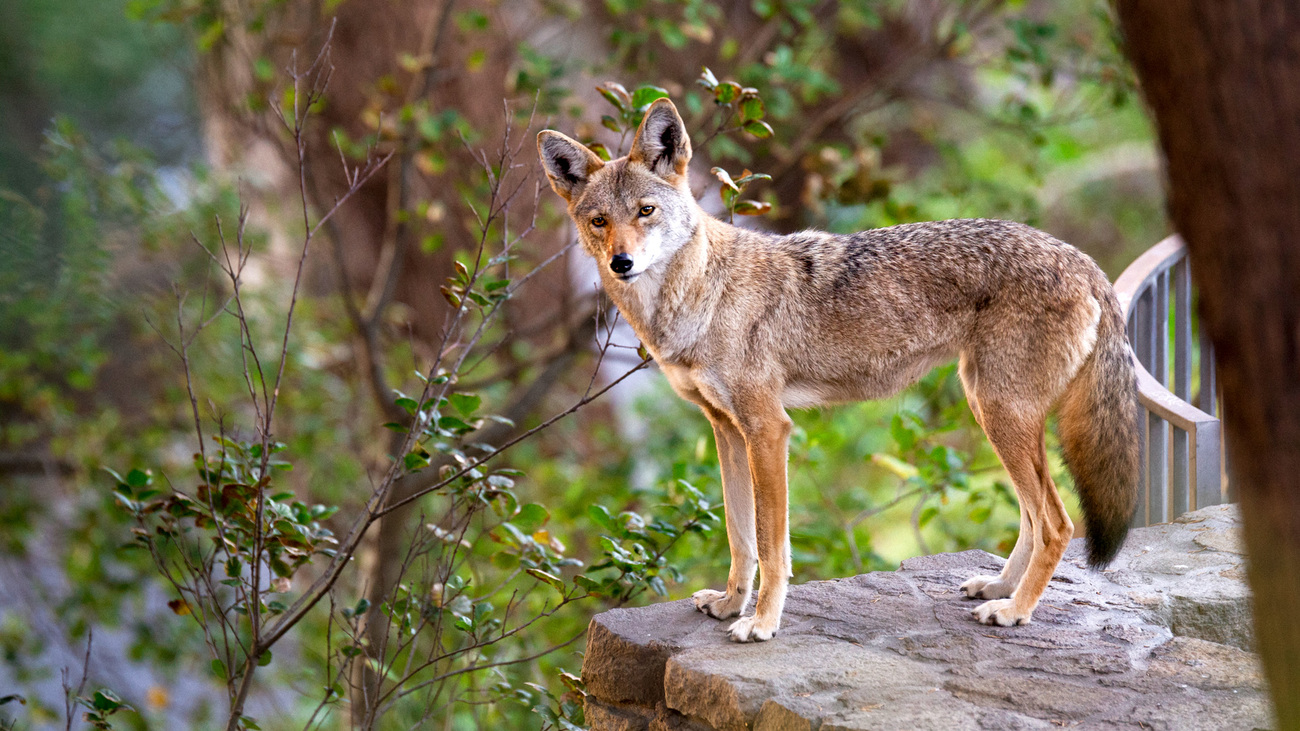
Humans
Humans pose a number of threats to coyotes, including:
Habitat loss
Human development reduces the coyote’s potential territory through urbanisation, agricultural expansion, and infrastructure growth. However, because they are so adaptable to various habitats and conditions, they may effectively acclimate to increasingly urban and suburban environments. Unfortunately, inhabiting human-dominated landscapes introduces a series of other challenges for coyotes, which we’ll explore below.
Conflict with humans
Where human and coyote populations share landscapes, concerns about conflicts–often based on misconceptions–has led people to kill coyotes. For example, in some areas, coyotes are treated as a threat to livestock and are subjected to trapping, shooting, or poisoning. While coyotes tend to avoid humans, they may become slightly less avoidant in urban environments where they are accustomed to seeing people. They are sometimes perceived as a threat to pets in such settings; fortunately, simple steps can protect pets and coyotes alike.
Hunting and trapping
It’s legal to hunt coyotes across much of the US, and some states have few restrictions on season, licensure or total kills. Hunting competitions reinforce this threat to coyotes, although some states have banned these killing contests in recent years. Coyotes are also subjected to trapping, including with steel-jaw leghold traps, snares, poison ejectors, and other inhumane devices.
Collisions
Human-caused coyote mortalities can sometimes be accidental. For instance, collisions with vehicles on roads are a significant cause of death for coyote populations in certain regions, particularly in urban settings.
Predation
Though not a significant cause of coyote mortality, larger animals such as cougars and wolves sometimes prey on coyotes. Even when they aren’t the prey, coyotes may have to compete with these larger mammals for available food sources.
Disease
Coyotes, like other wild mammals, are susceptible to infectious diseases such as mange, canine distemper, and rabies. They are more likely to die from these diseases during colder months.
FAQs
What does a coyote look like?
Coyotes are members of the dog family and resemble smaller wolves. They are medium-sized canids with a maximum body length of about 1.3 metres (4.3 feet)—including the length of their bushy, black-tipped tail—and a height of roughly 60 centimetres (2 feet). Their weight can vary from nine to 23 kilograms (20 to 50 pounds), depending on region or food availability.
Coyotes typically have dense, greyish-brown coats with patches of reddish fur and lighter undersides. Their coats can sometimes change slightly in colour, depending on the season. They have large, pointed ears that stand on top of their heads, which help give them excellent hearing.
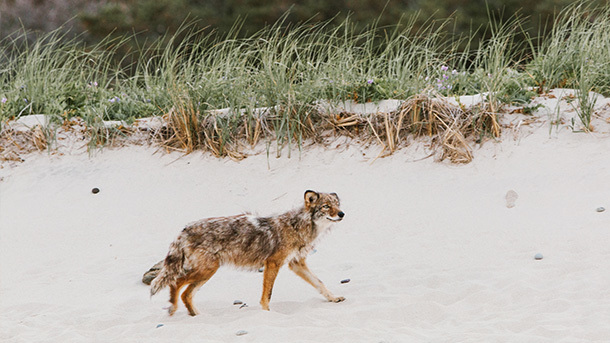
What does a coyote sound like?
Coyotes are known for their distinctive howl and yapping sounds, often heard throughout the night. They have diverse calls and vocalisations that serve different communication purposes.
Howling is thought to communicate a coyote’s location to other pack members, to gather the pack, or to establish territorial boundaries. Howls can range from low, mournful sounds to high-pitched yips and yowls.
Coyotes also make short, sharp yips and yaps, often used during playful interactions within the pack.
When alarmed or threatened, coyotes bark rapidly and repetitively. Depending on the perceived danger, this bark can vary in intensity and frequency.
Coyotes use softer, whining sounds to communicate submission or express distress, especially during social interactions or when injured.
What do coyotes eat?
Coyotes are opportunistic feeders, meaning they’ll eat what is available and rely on a range of food sources. They primarily feed on small mammals like rabbits and rodents, but they’re also known to consume frogs, fish, snakes, and carrion. They are omnivores and may also consume insects, fruit, and grass.
Where do coyotes live?
Coyotes are widely distributed across North America, except for the polar regions. They also occupy Central America.
How big is a coyote?
Coyotes are significantly smaller than wolves. Their bodies are typically up to 1.3 metres (4.26 feet) long, standing approximately 60 centimetres (2 feet) tall. A coyote can weigh 9 to 23 kilograms (20-50 pounds), but it depends on where they’re found and the abundance of available prey.
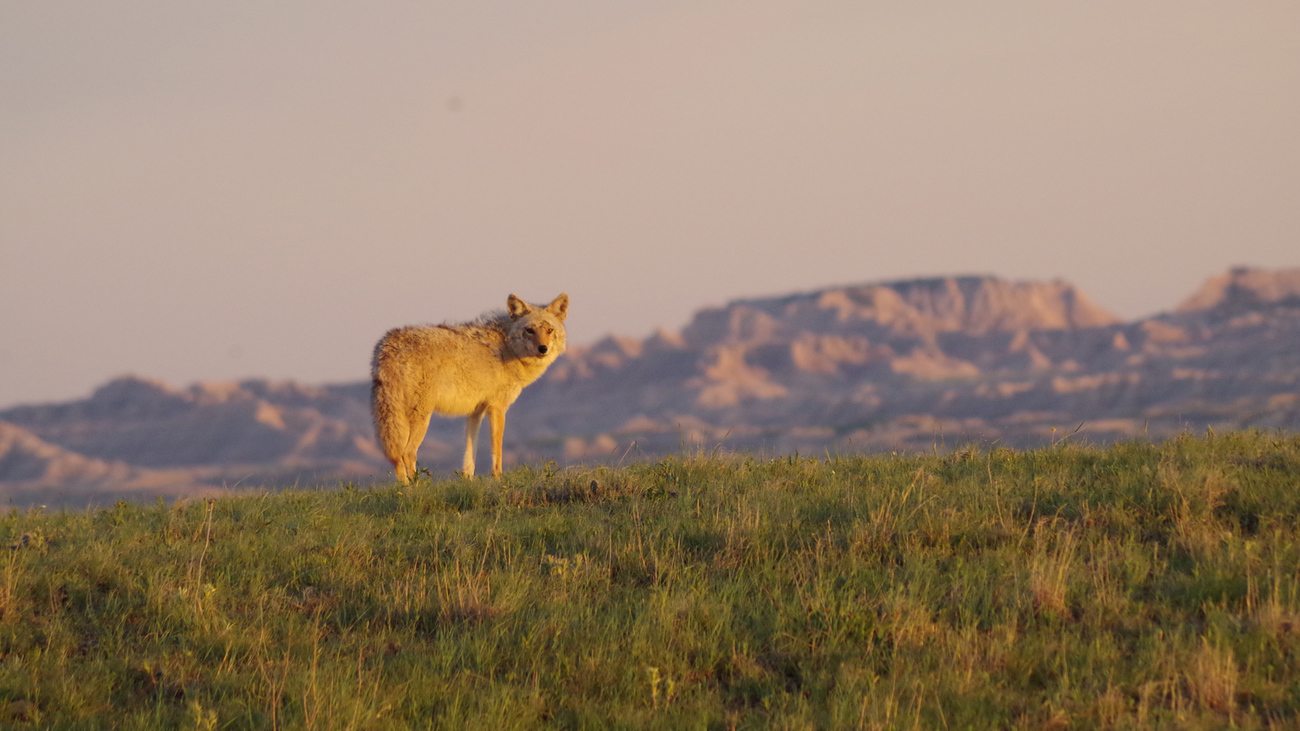
Are coyotes nocturnal?
While coyotes are known for their nighttime vocalisations, they’re not considered to be nocturnal. They may be active at all times of the day, though they tend to be most active after sunset and during the night.
How fast can a coyote run?
Coyotes can reach speeds of up to 64 kilometres per hour (40 miles per hour).
What is a baby coyote called?
Baby coyotes are called pups.
When do coyotes have pups?
Adult coyotes breed between January and March. After a gestation period of 58 to 65 days, they give birth to a litter of up to seven pups. However, litter size can vary depending on the food availability in their habitat.
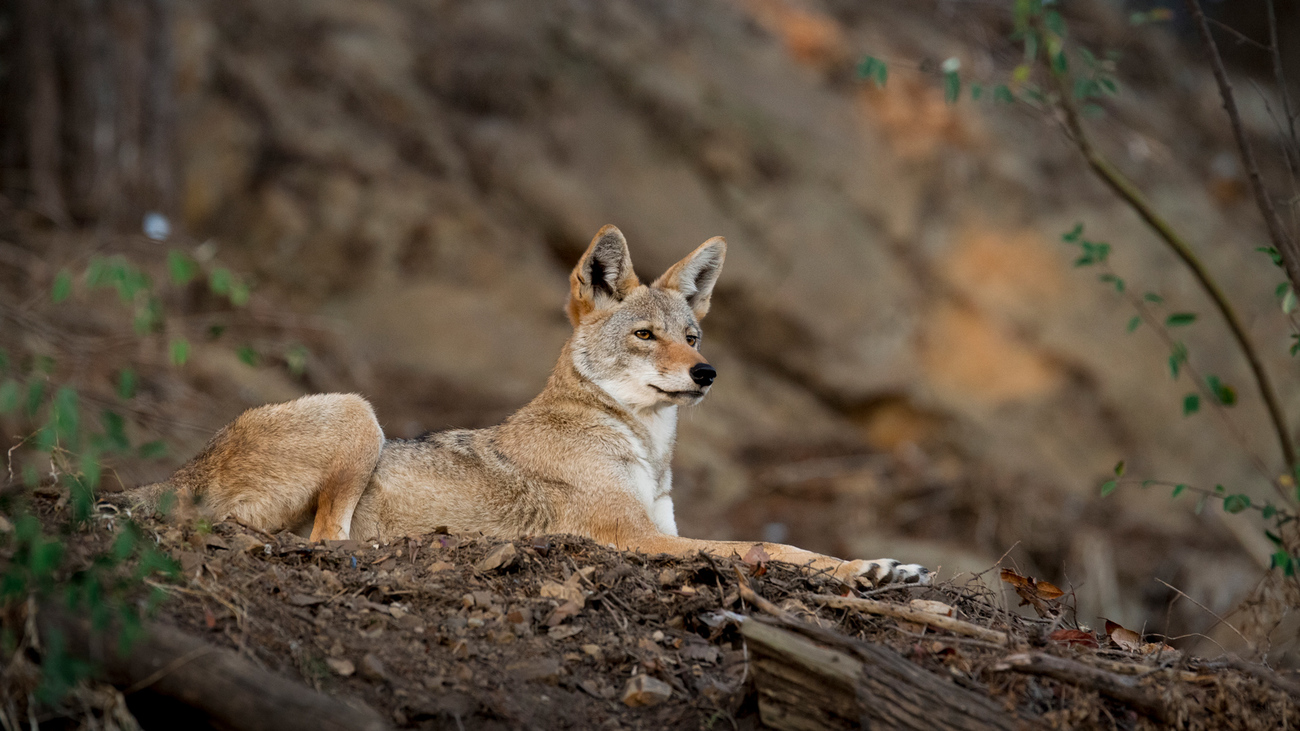
Do coyotes hunt in packs?
Coyotes tend to hunt either individually or in pairs.
Do coyotes attack humans?
Coyotes tend to fear humans and avoid them. They may become habituated where people feed them (either intentionally or unintentionally). Unintentional feeding occurs when coyotes can access rubbish bins, bird feeders, or food that is left outdoors.
To avoid habituating coyotes, it is important to limit their access to refuse and other potential food sources, keep pets indoors, and, in some cases, install appropriate fencing and other deterrents.
Our work
At IFAW, we’re working to change the perspective on wildlife in human-dominated areas. We’re working with communities to encourage behaviours that support the coexistence of humans with local wild animals. Humans often feel particularly hostile towards coyotes, but we’re looking to change that narrative by educating people about their critical role in the health of our planet and ecosystems. This campaign involves the removal of cruel traps and poisons, making the US safer for coyotes, other wild animals, and humans.
We’re also supporters of Project Coyote, an initiative by Camilla Fox to dispel misconceptions about coyotes and emphasise the importance of peaceful cohabitation with these animals.
With approximately half a million coyotes being killed annually in the US, often using inhumane methods, Project Coyote involves educating communities and policymakers to promote non-lethal, humane coexistence practices. One notable success story is the Marin County Livestock and Wildlife Protection Program (MCLWPP), which reduced predator-related livestock losses by 62% through non-lethal measures like fencing, predator deterrents, and cost-sharing support.
As well as encouraging communities to stop the lethal and inhumane management of wildlife, we’re also lobbying Congress to restrict federal funding for these activities. IFAW calls for Canyon’s Law, a federal ban on M-44s. The M-44 cyanide bomb is a device used in federal ‘nuisance’ predator-killing programmes. These poison devices have caused several human and pet injuries across the US.
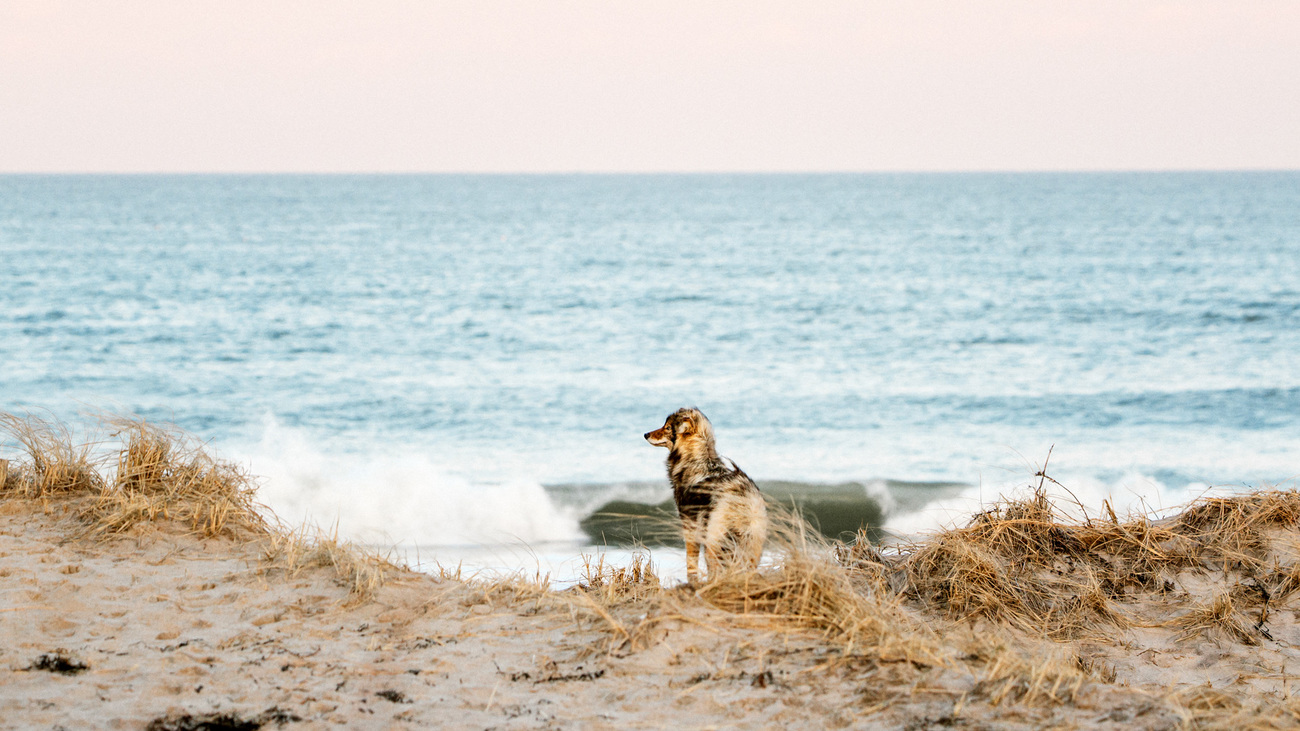
How can you help?
We must understand how we share our world with nature and that coexistence with wildlife like coyotes isn’t just possible—it’s necessary.
